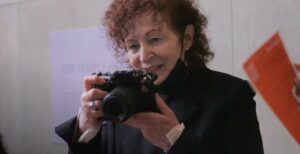Directed by Laura Poitras | 122 min | ▲▲▲▲△ | VOD and Digital
It’s not every day you see a documentary that does as good a job as this one balancing a dual narrative over the course of two hours. A fellow cinepanion said she’d happily spend a few more hours with the characters here, and I had to agree with her. That might be the only drawback I can see to the film, directed by CitizenFour‘s Poitras: It deftly tells its two parallel tales, but imagine what another hour of movie might’ve given us. It’s not often you want more story.
The two tales sharing the film both involve legendary art photographer and activist Nan Goldin.
The first is set in the recent past and present day and detail her and her compatriots’ efforts to draw attention to the Sackler family. These are the wildly rich Americans who ran Purdue Pharma, the company that mislead the public about the addictive properties of Oxycontin to the tune of billions of dollars and helped kickstart the current opioid crisis. The family also is a big name in the arts in the US and UK, giving millions to galleries in New York and London. That’s where Goldin strikes with her activist events, and given her profile — her work features in many of these galleries — she’s attacking the problem from the inside out. She’s also a survivor, having lived with addiction.
The other tale told here is about Goldin’s background, her growing up with dysfunctional parents and a sister who committed suicide, her time living and working in the Bowery in Manhattan in the late 1970s and 1980s, her photography documenting those who lived, partied, and died there into the era of AIDS.
All of this is fascinating — her frank testimonials about what life was like then, backed up by her vivid photographic evidence. The film is entirely successful in recreating that time and could’ve been entirely devoted to it — I would’ve been interested in hearing more from those who were there and what they thought of Goldin’s efforts to find legitimacy in the male-dominated art world.
Some of the figures here — like David Wojnarowicz — were familiar to me from other documentaries of the period, but I’d have loved to have heard from John Waters or Jim Jarmusch, both of whom feature in Goldin’s slideshows.
The activist stuff with the Sacklers is also entirely compelling — but I’d have liked to have heard even more background, maybe from investigative journalists talking about how this family business promoted its highly addictive product to Americans (and Canadians) and how, later on, it removed billions of dollars from Purdue before the company declared bankruptcy.
All that said, I’ll reiterate: the film as it exists now is entirely successful. It just left me wanting more. I guess I’ll be doing a lot of reading.














